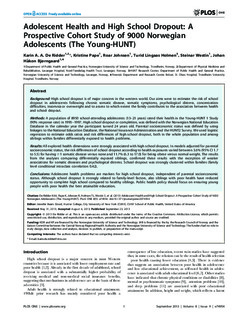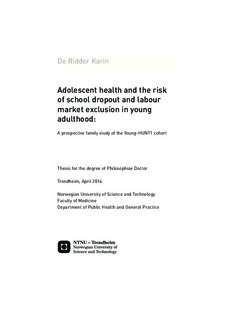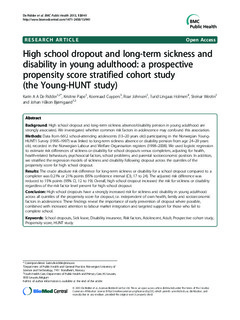| dc.contributor.author | De Ridder, Karin | nb_NO |
| dc.date.accessioned | 2014-12-19T14:23:08Z | |
| dc.date.available | 2014-12-19T14:23:08Z | |
| dc.date.created | 2014-05-21 | nb_NO |
| dc.date.issued | 2014 | nb_NO |
| dc.identifier | 718453 | nb_NO |
| dc.identifier.isbn | 978-82-326-0130-1 (printed ver.) | nb_NO |
| dc.identifier.isbn | 978-82-326-0131-8 (electronic ver.) | nb_NO |
| dc.identifier.uri | http://hdl.handle.net/11250/264584 | |
| dc.description.abstract | Background
High school dropout and problematic work integration in young adulthood represent an individual hazard and a societal challenge in most Western countries. Health problems with varying degree of functional limitations are common in adolescence, and there is some evidence to suggest a higher risk of sickness and disability among high school dropouts compared to high school completers. Prospective studies of the complex role of adolescent health, socioeconomic factors and family context for completion of secondary school and subsequent problematic labour market integration due to ill health are rare.
Aims
The main objective of the thesis was to study, with a prospective design, the associations between adolescent health, high school dropout and long-term social insurance benefits in young adulthood. We investigated whether adolescent health and health-related vulnerability confounded the association between school dropout and long-term social insurance benefits. We studied the associations between several dimensions of self-reported health in adolescence and school dropout. For all these associations, we assessed the contribution of socioeconomic factors and the family context.
Methods
Our study population was 8795 school attending adolescents (13-21 years) who participated in the Young-Hunt1 Survey in the county Nord-Trøndelag, Norway (1995-1997). The information of the questionnaire was combined with national register based information on education and social insurance benefits from 1998 to 2007/2008. High school dropout or completion was defined with the Norwegian National Education Database (NUDB) in the calendar year the participant turned 24 years old. We recorded long-term social insurance benefits, such as long-term (more than 180 days/calendar year) sickness absence, rehabilitation benefits, disability benefits, long-term unemployment, and social insurance support in the Norwegian Labour and Welfare registers (FD-Trygd). Parental information on socioeconomic position and linkage of siblings was obtained by the NUDB, FD-Trygd and the HUNT2 survey. The main adolescent health exposures from Young-Hunt1 Survey were chronic somatic disease, somatic symptoms, psychological distress, concentration difficulties, insomnia, self-reported health and overweight. Common risk factors that could confound the association between dropout and benefits were the various adolescent health dimensions, health-related behaviours, psychosocial factors, school problems, and parental socioeconomic position. Health-related vulnerability for dropout was estimated with a propensity score for high school dropout based on these common risk factors.
We assessed the associations between the different adolescent health dimensions and school dropout, and between school dropout and long-term social insurance benefits with descriptive statistics and various logistic regression models, both in the whole population and among siblings.
Results
In the Young-HUNT1 cohort, a total of 17% was registered as high school dropouts at age 24. The predicted 5-year risk for receiving long-term social insurance benefits between ages 24- 28 was 21% (95% CI 20% to 23%). High school dropouts had about a 3-fold higher risk for receiving long-term benefits and poor self-rated health was associated with receiving both medical and non-medical benefits in the models adjusted for parental socioeconomic position. (Paper I)
All explored health dimensions were strongly associated with high school dropout, also in the models adjusted for parental socioeconomic position. The results were confirmed in the analyses comparing differentially exposed siblings, with the exception for chronic somatic disease and psychological distress. School dropout was strongly clustered within families. (Paper II)
High school dropouts have a strongly increased risk for long-term sickness benefits and disability pension between ages 24-29 across all vulnerability or risk factor level for school dropout, i.e. independent of own health, family and socioeconomic factors in adolescence. Strong associations between dropout and receipt of benefits were also present when comparing siblings. (Paper III)
Conclusions
High school dropout and receipt of long-term social insurance benefits in young adulthood are substantive problems both for the individual and society. All examined dimensions of health in adolescence were associated with school dropout. High school dropout increased the risk for sickness and disability regardless of the risk factor level present for school dropout. Although the family context was very important for both dropout and receipt of benefits, most associations were confirmed in sibling comparisons. Future research on educational attainment and labour market exclusion in young adulthood should also have attention to health-related mechanisms. For policy, our findings support the importance of prevention of school dropout where possible, in combination with increased attention to labour market integration and targeted support for those who fail to complete high school. The results also support that adolescent health should have a central role in public health policy. | nb_NO |
| dc.language | eng | nb_NO |
| dc.publisher | Norges teknisk-naturvitenskapelige universitet, Det medisinske fakultet, Institutt for samfunnsmedisin | nb_NO |
| dc.relation.ispartofseries | Doktoravhandlinger ved NTNU, 1503-8181; 2014:103 | nb_NO |
| dc.relation.haspart | De Ridder, Karin A A; Pape, Kristine; Johnsen, Roar; Westin, Steinar; Holmen, Turid Lingaas; Bjørngaard, Johan Håkon. School dropout: a major public health challenge. Journal of Epidemiology and Community Health. (ISSN 0143-005X). 66(11): 995-1000, 2012. <a href='http://dx.doi.org/10.1136/jech-2011-200047'>10.1136/jech-2011-200047</a>. <a href='http://www.ncbi.nlm.nih.gov/pubmed/22315238'>22315238</a>. | nb_NO |
| dc.relation.haspart | De Ridder, Karin A A; Pape, Kristine; Johnsen, Roar; Holmen, Turid Lingaas; Westin, Steinar; Bjørngaard, Johan Håkon. Adolescent health and high school dropout. PloS one. (ISSN 1932-6203). 8(9): e74954, 2013. <a href='http://dx.doi.org/10.1371/journal.pone.0074954'>10.1371/journal.pone.0074954</a>. <a href='http://www.ncbi.nlm.nih.gov/pubmed/24086408'>24086408</a>. | nb_NO |
| dc.relation.haspart | De Ridder, Karin A A; Pape, Kristine; Cuypers, Koenraad; Johnsen, Roar; Holmen, Turid Lingaas; Westin, Steinar; Bjørngaard, Johan Håkon. High school dropout and long-term sickness and disability in young adulthood. BMC public health. (ISSN 1471-2458). 13: 941, 2013. <a href='http://dx.doi.org/10.1186/1471-2458-13-941'>10.1186/1471-2458-13-941</a>. <a href='http://www.ncbi.nlm.nih.gov/pubmed/24103558'>24103558</a>. | nb_NO |
| dc.title | Adolescent health and the risk of school dropout and labour market exclusion in young adulthood | nb_NO |
| dc.type | Doctoral thesis | nb_NO |
| dc.contributor.department | Norges teknisk-naturvitenskapelige universitet, Det medisinske fakultet, Institutt for samfunnsmedisin | nb_NO |
| dc.description.degree | PhD i samfunnsmedisin | nb_NO |
| dc.description.degree | PhD in Community Medicine | en_GB |



